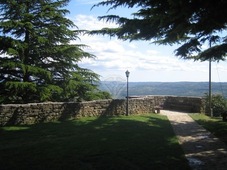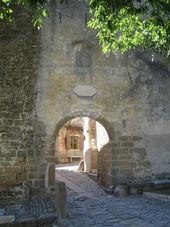to enlarge


or choose the place
from the menu below
 Rome |
 Byzantium |
 Venice |
 Vienna |
 Brioni |
 Smrikve |
 |
 |
Some sources indicate that the antique name for the town was probably Graeciniana. It is likely that the name derives from the word Grisium that means rocky hill, Grisignana in latin.
 Like most of the Istrian towns, Groznjan
was also a prehistoric hill fort settlement and it was a settlement in the Roman period. It is mentioned for the first time
in 1102 when the Marquis of Istria, Ulrich II of Weimar, donated Groznjan to the Aquileia Patriarchs.
Like most of the Istrian towns, Groznjan
was also a prehistoric hill fort settlement and it was a settlement in the Roman period. It is mentioned for the first time
in 1102 when the Marquis of Istria, Ulrich II of Weimar, donated Groznjan to the Aquileia Patriarchs.
In 1238, Groznjan was under Kostel‘s administration. When Peter of Kostel died in 1338, Groznjan turned back to the Aquileia Patriarchs.
From 1353 until 1358 it was owned by Ulrich of Reifenberg. Groznjan was involved in several battles during that time.
In 1358, Venetians bought Groznjan for 4,000 ducats and from then onwards the Republic of Venice ruled over Groznjan until its fall.
During the Venice domination, Groznjan became the centre of its administration for the northern part of Venetian lands in Istria and it had that role for several decades.
In 1359, Pietro Dolfin, the Captain of Pasenatico, moved from Umag to Groznjan. During this few decades Groznjan was the headquarters of the Venetian administration of Pasenatico until it was moved in 1394 to Raspor.
Groznjan was affected by the Venice wars with Austria at the beginning of the 17th century, and after the fall of Venice, Groznjan became part of the Austrian Empire that later on evolved into the Austro-Hungarian Monarchy. Groznan was also for a short period of time under the Napoleon’s administration.
After the dissolution of the Austro-Hungarian Monarchy Groznjan became part of Italy and after the Second World War part of Yugoslavia (Croatia).
During the Italian Fascist period in Istria many Istrian families suffered from the regime or had to leave Istria. Fascism in Istria applied various repressive measures mostly towards Slav populations and this created the Antifascist Movement. The Second World War was a very painful experience for the Istrian population and many innocent Istrians, both Slav and Latin, died during that war.
After the second World War Groznjan became part of Yugoslavia (Croatia). There were three agreements between Yugoslavia and Italy which established that Istria would become a part of Yugoslavia: Paris Agreement of 1947, London Memorandum of 1954 and the Osimo Agreement reached in 1975.
In the first decade after the Second World War many Istrians, especially those living in towns and villages that for centuries were part of the Venice Republic, decided to leave Istria.
In 1991 with the fall of Yugoslavia and the founding of the Republic of Croatia, the internal republic boundaries were recognised as the state boundaries and Groznjan is today part of Croatia.
In 2013 Groznjan became part of the European Union. You can not change the past but you can try to learn from it. The main aim of the European Union founders was to build a system that could avoid future wars and future refugees in Europe as I explain in COSMOPOLITE.
GROZNJAN – VIRTUAL TOUR
 If you arrive from the Buje direction,
you will park your car near the Venetian stone column. Otherwise, if you arrive from the Ponte Porton direction
you will pass near the main town gates and a small Church of St. Cosmas and Damian.
If you arrive from the Buje direction,
you will park your car near the Venetian stone column. Otherwise, if you arrive from the Ponte Porton direction
you will pass near the main town gates and a small Church of St. Cosmas and Damian.
When you park the car, arriving from Buje, and start walking towards the old town you will first pass near the Venetian stone column above the part of the walls. In the past here were located the secondary town gates.
Groznjan was surrounded by the city walls, like many Istria medieval towns, and the walls you see today were renovated in the 14th century.